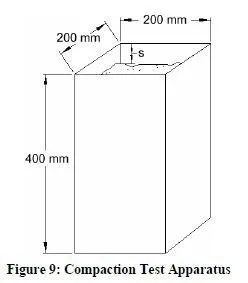Developed in France, the BTRHEOM rheometer (de Lerrard et al. 1997; de Lerrard 1999; Wong et al. 2000; Ferraris and Brower 2001; Bartos, Sonebi, and Tamimi 2002) is a parallel plate rheometer that measures the yield stress and plastic viscosity of concrete.
The device consists of a 240 mm diameter, 100 mm tall cylindrical container with blades mounted at the top and bottom of the container. The bottom blade is fixed while the top blade rotates and measures torque. The motor is housed below the container and is connected to the top blade through a 40 mm diameter inner shaft in the concrete container. The device includes a vibrator to consolidate the concrete and to measure the effect of vibration on the rheological parameters. The test is conducted by turning the top blade at different speeds and recording the resulting torque. The torque is recorded after a 20 second period in order to allow the shear rate to stabilize.
Computer software developed for the BTRHEOM rheometer automatically calculates the Bingham parameters of yield stress and plastic viscosity. Further, the data generated in the software can be used to calculate the flow curve in terms of the Herschel-Bulkley parameters. The device records torque, Î , and rotation speed, N, which are related according to Equation[11], where A and b are empirical constants.
Î = Î + ANb
Equation [11] is similar to the flow equation for a Herschel-Bulkley fluid, as expressed in
Equation [12] whereτ = shear stress, 0 τ = yield stress, γ = shear velocity gradient, and a and b
are empirical constants:
τ =τ + aγ^b
The relationship between shear stress and the shear velocity gradient can be further simplified in
terms of the Bingham parameters of yield stress and plastic viscosity, μ :
τ =τ + μγ
The BTRHEOM rheometer is capable of measuring dilatancy during a test. In addition to calculating the yield stress, 0 ??„ , as shown above, the yield stress at rest can be determined using a stress controlled test. The determination of yield stress at rest is appropriate for highly thixotropic concrete mixes.
Since the initial development of the BTRHEOM rheometer, the accuracy of the device has been validated experimentally and analytically (Hu et al. 1996).
A simplified version of the BTRHEOM rheometer has been developed to eliminate several drawbacks of the original device (Szecsy 1997). In the simplified version, the motor is located above the bowl. As a result, fewer parts are necessary. Instead of using two felt seals that must be replaced frequently, the simplified version only requires a single rubber o-ring.
Advantages:
The device measures yield stress, plastic viscosity, yield stress at rest, and dilatancy.
The parallel plate geometry of the BTRHEOM rheometer eliminates some of the drawbacks of coaxial cylinders geometry.
The results of the test have been verified with finite element models.
The operation of the device is computer controlled, requiring little user intervention.
A built-in vibrator allows the measurement of rheological properties under vibration.
Disadvantages:
The device is complex and expensive.
The seals must be replaced frequently. The device must be recalibrated to account for the friction caused by new seals.
Although the device is designed to be compact and sufficiently rugged for field use, the device is too expensive for everyday field use.
The device does not measure low workability concretes (generally with slumps less than 4 inches).


Please advise address of manufacturer of BTRHEOM rheometer for fresh self consolidating concrete
It is good device developed for Lab as well as for field investigations. It is stated to be computer controlled, but as the number of parameters is less, a small mutichanne DAQ may be useful in making it more compact.